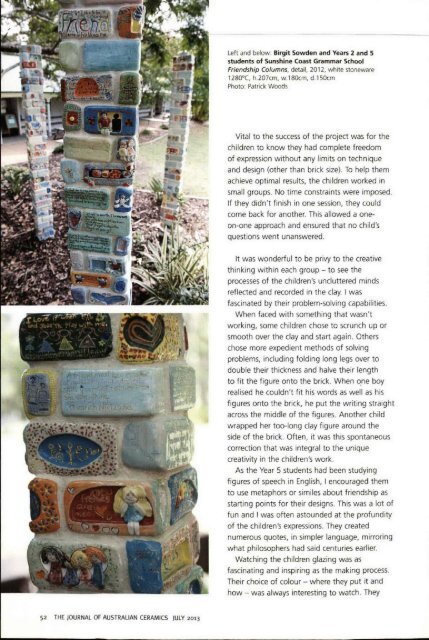The Journal of Australian Ceramics Vol 52 No 2 July 2013
You also want an ePaper? Increase the reach of your titles
YUMPU automatically turns print PDFs into web optimized ePapers that Google loves.
left and below: Birgit Sowden and Years 2 and 5<br />
students <strong>of</strong> Sunshine Coast Grammar School<br />
Friendship Columns, detail, 2012, white stoneware<br />
1280"C. h.207cm. w. 18OCm. d.l SOcm<br />
Photo: Patrick. Woods<br />
Vital to the success <strong>of</strong> the project was for the<br />
children to know they had complete freedom<br />
<strong>of</strong> expression without any limits on technique<br />
and design (other than brick size). To help them<br />
achieve optimal results. the children worked in<br />
small groups. <strong>No</strong> time constraints were imposed.<br />
If they didn't finish in one session, they could<br />
come back for another. This allowed a oneon-one<br />
approach and ensured that no child's<br />
questions went unanswered.<br />
It was wonderful to be privy to the creative<br />
thinking within each group - to see the<br />
processes <strong>of</strong> the children's uncluttered minds<br />
reflected and recorded in the clay. I was<br />
fascinated by their problem-solving capa bilities.<br />
When faced with something that wasn't<br />
working, some children chose to scrunch up or<br />
smooth over the clay and start again. others<br />
chose more expedient methods <strong>of</strong> solving<br />
problems, including folding long legs over to<br />
double their thickness and halve their length<br />
to fit the figure onto the brick. When ~ne boy<br />
realised he couldn't fit his words as well as his<br />
figures onto the brick. he put the writing straight<br />
across the middle <strong>of</strong> the figures. Another child<br />
wrapped her too-long clay figure around the<br />
side <strong>of</strong> the brick. Often, it was this spontaneous<br />
correction that was integral to the unique<br />
creativity in the children's work.<br />
As the Year 5 students had been studying<br />
figures <strong>of</strong> speech in English, I encouraged them<br />
to use metaphors or similes about friendship as<br />
starting points for their designs. This was a lot <strong>of</strong><br />
fun and I was <strong>of</strong>ten astounded at the pr<strong>of</strong>undity<br />
<strong>of</strong> the children's expressions. <strong>The</strong>y created<br />
numerous quotes, in simpler language, mirroring<br />
what philosophers had said centuries earlier.<br />
Watching the children glazing was as<br />
fascinating and inspiring as the making process.<br />
<strong>The</strong>ir choice <strong>of</strong> colour - where they put it and<br />
how - was always interesting to watch. <strong>The</strong>y<br />
<strong>52</strong> THE 10URNAl OF AUSTRALIAN CERAMICS IUl Y <strong>2013</strong>

















